
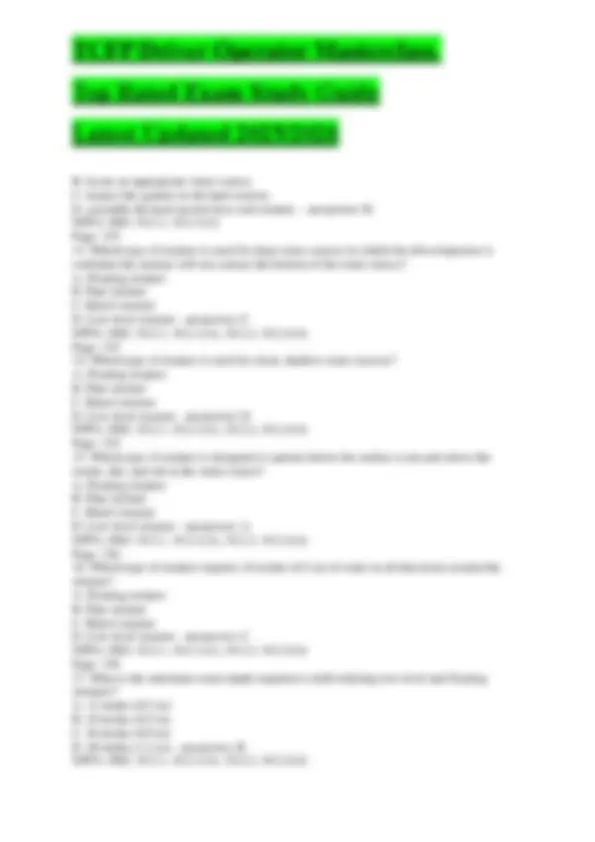
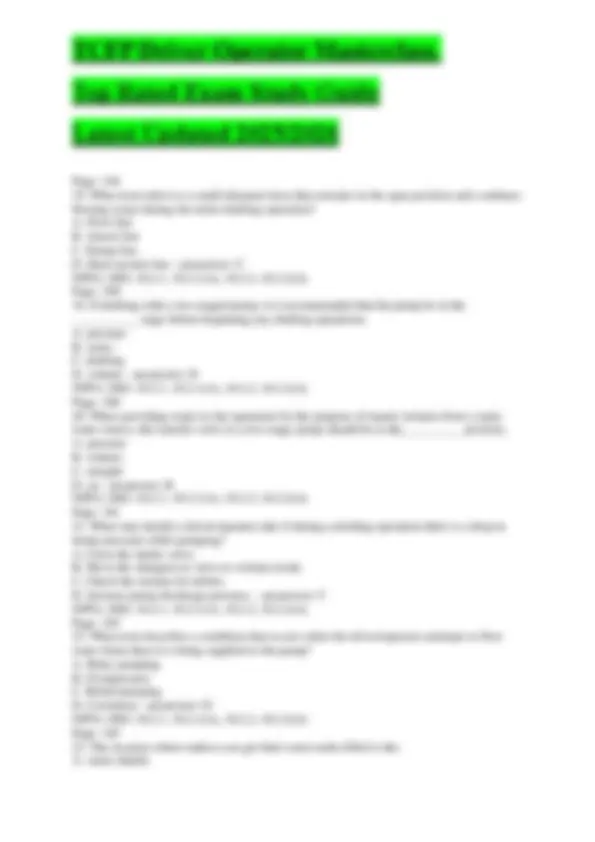
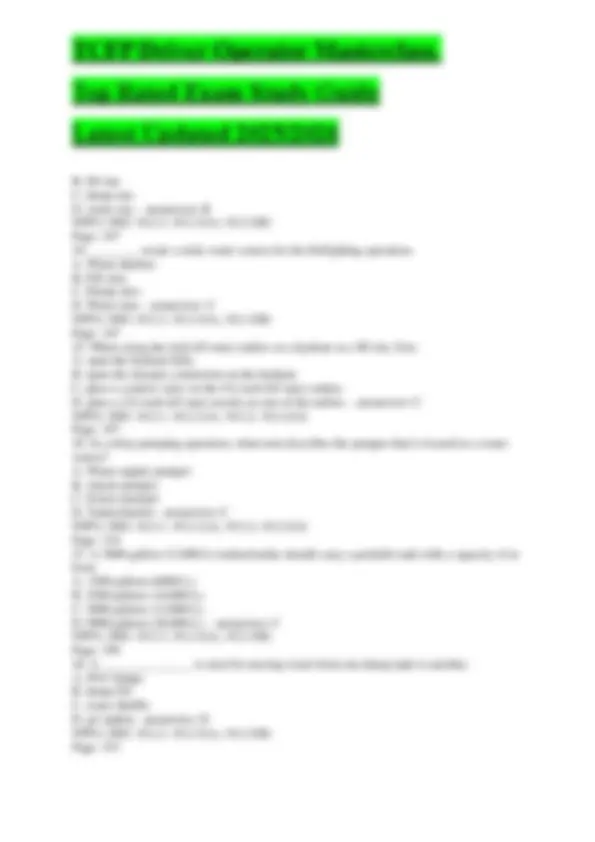
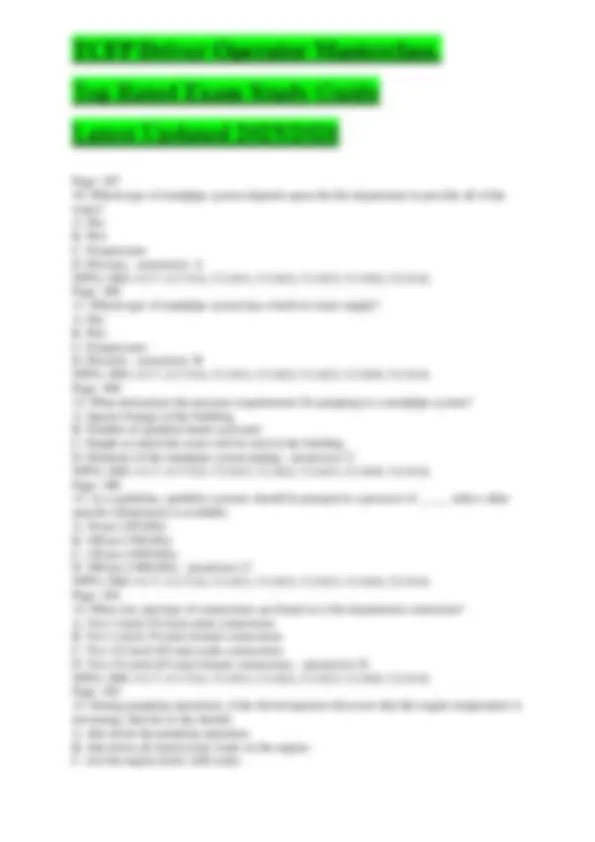
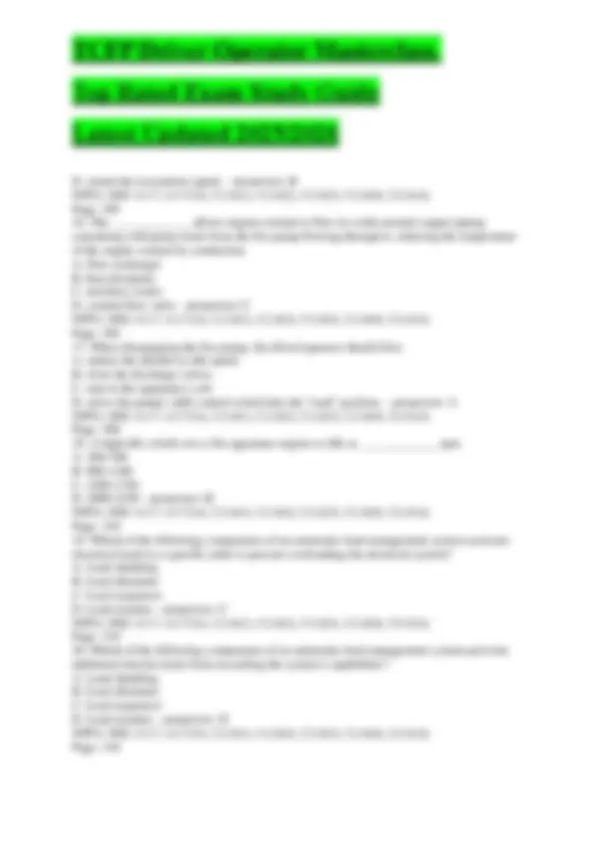
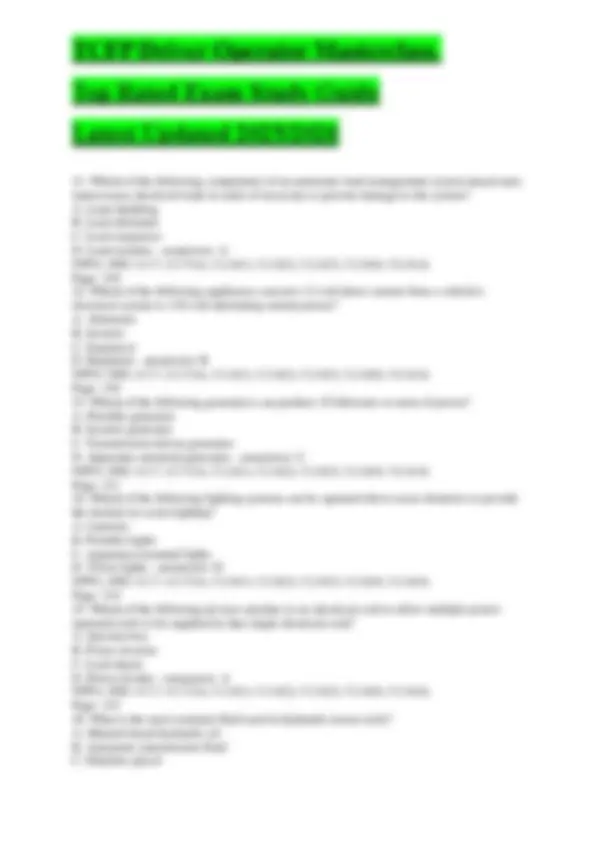
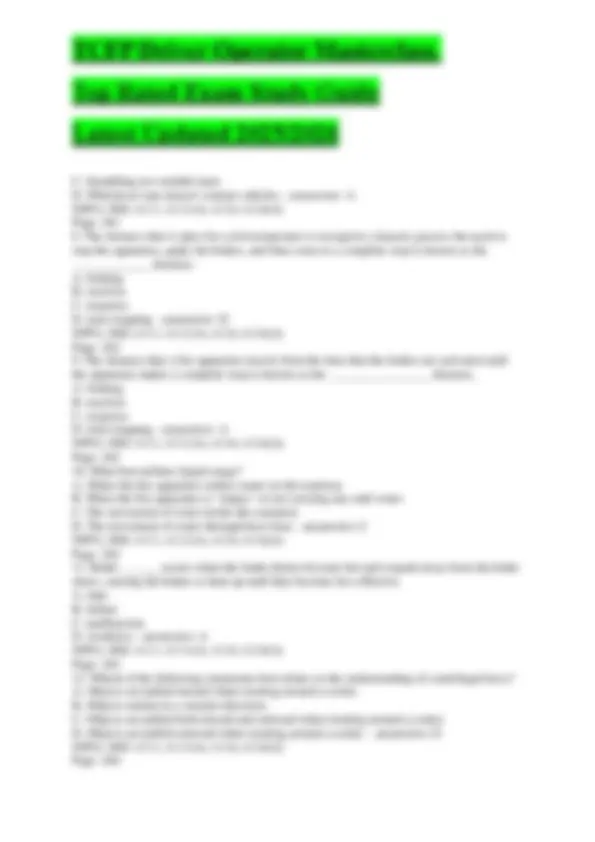
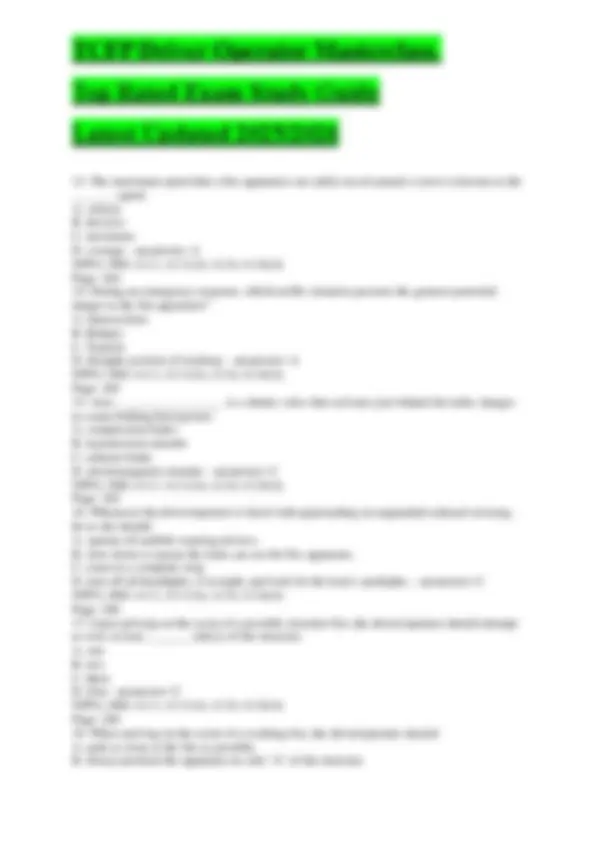
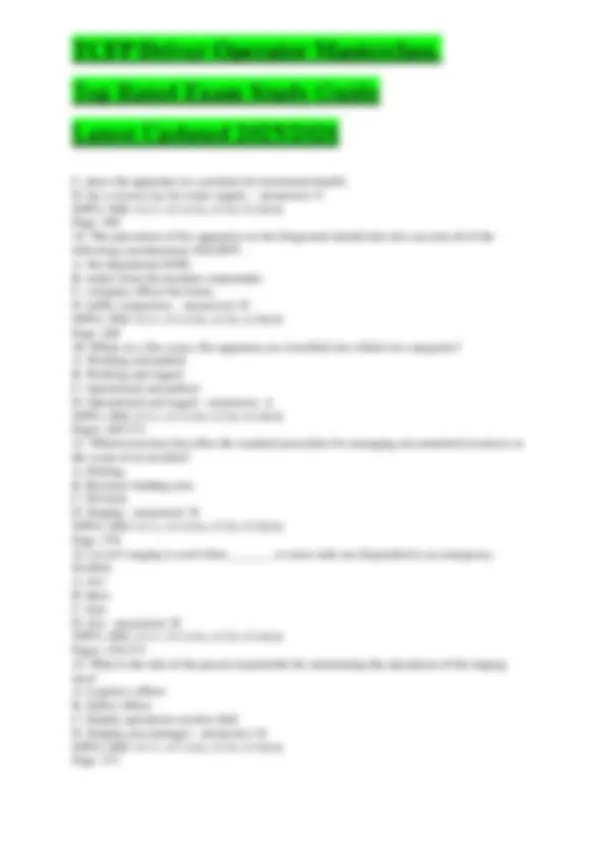
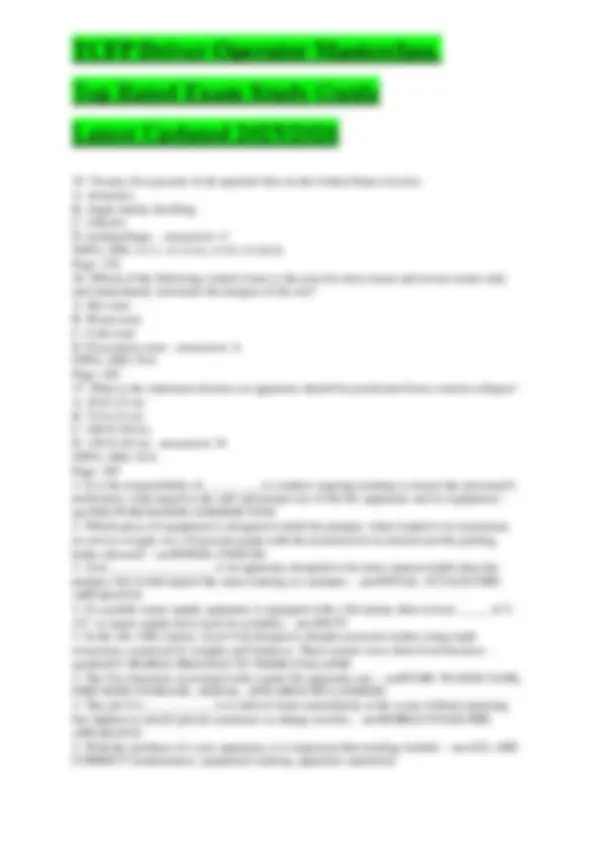
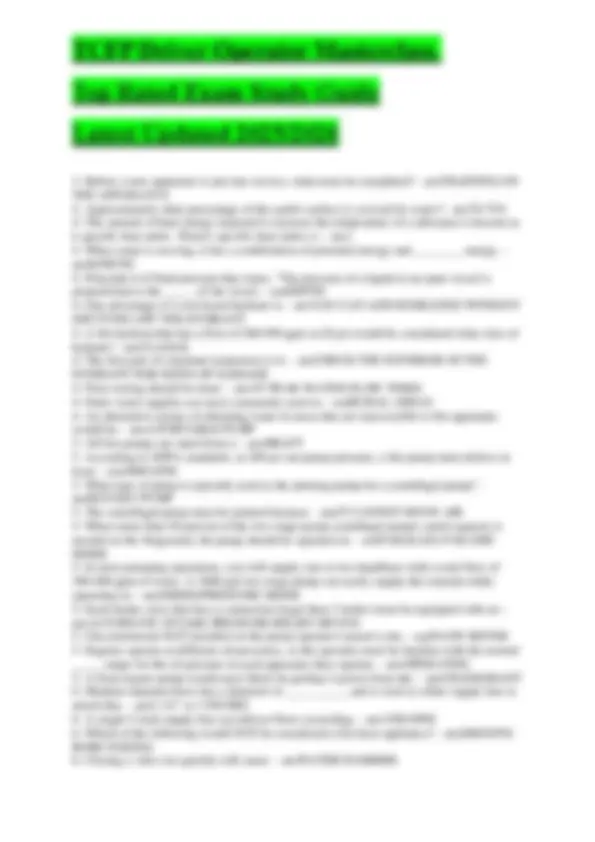
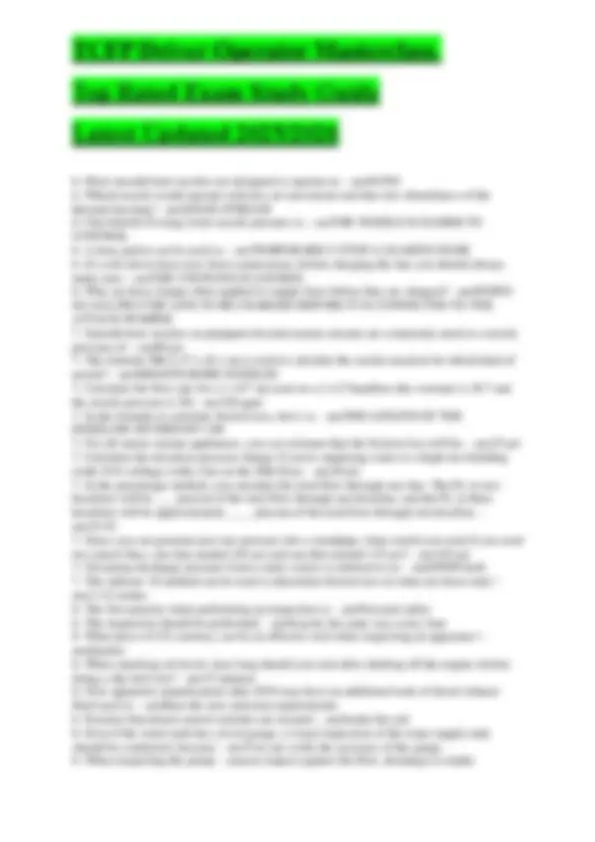
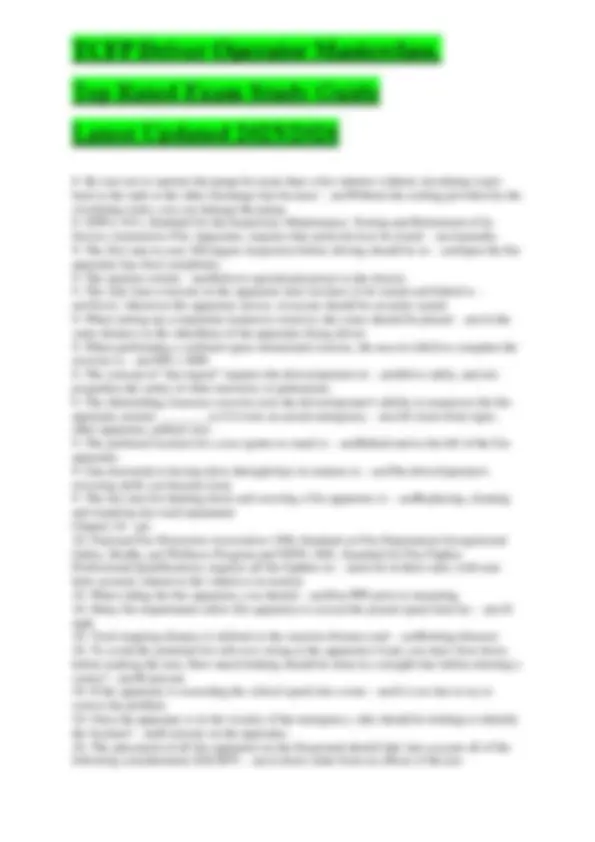
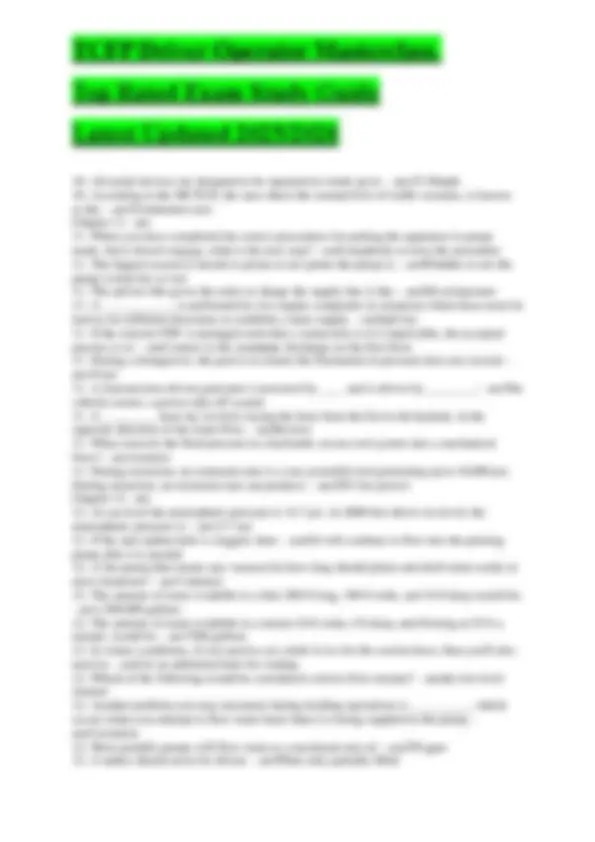

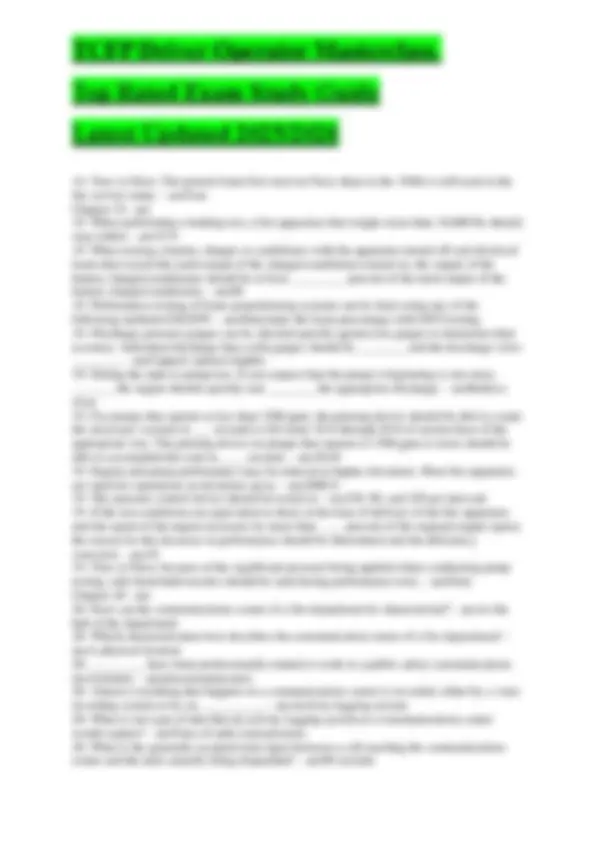
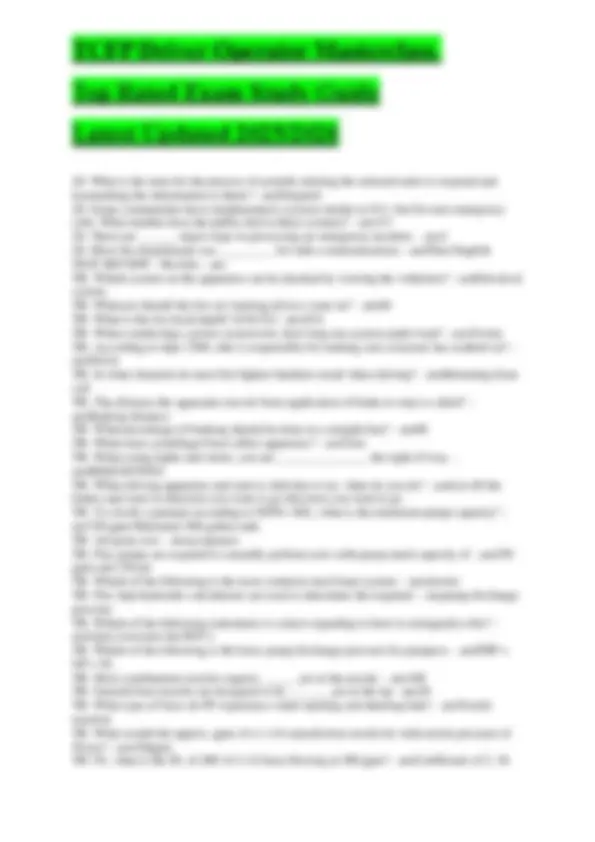
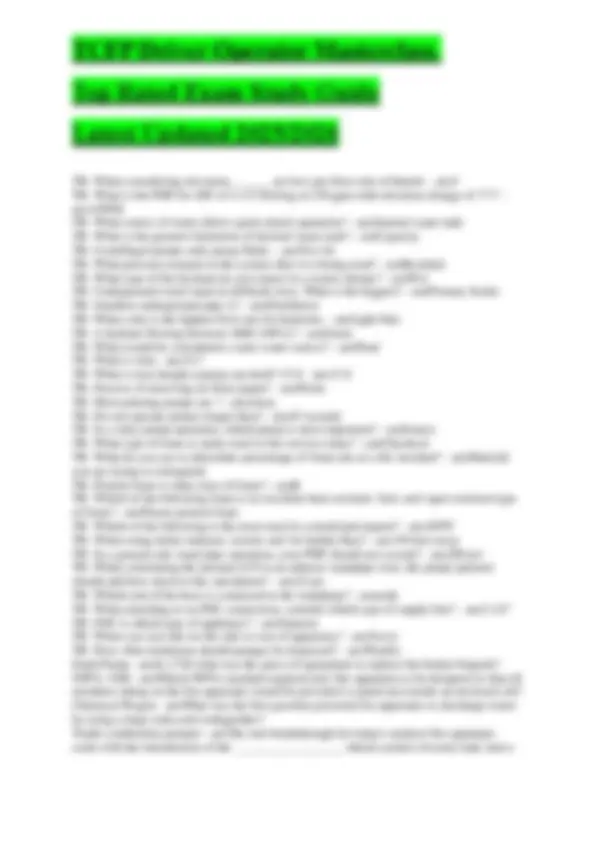
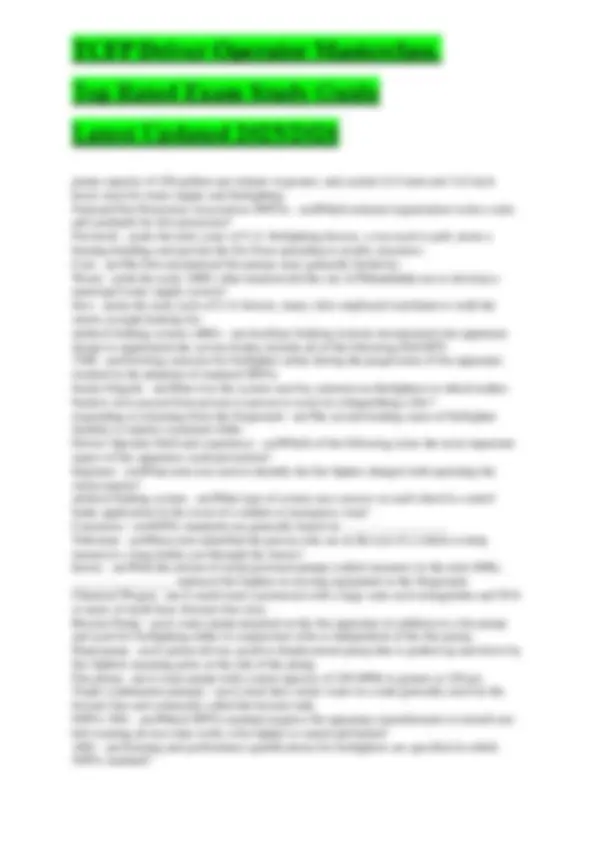
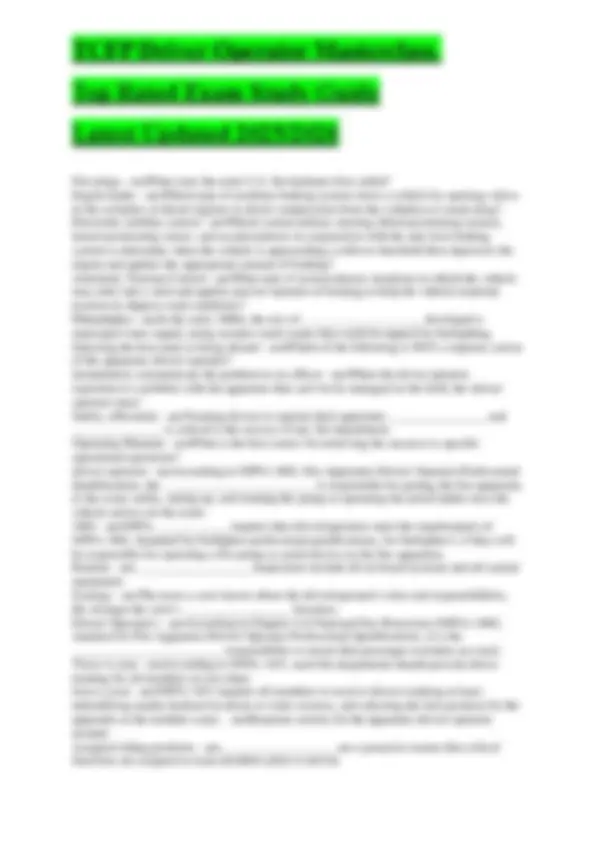
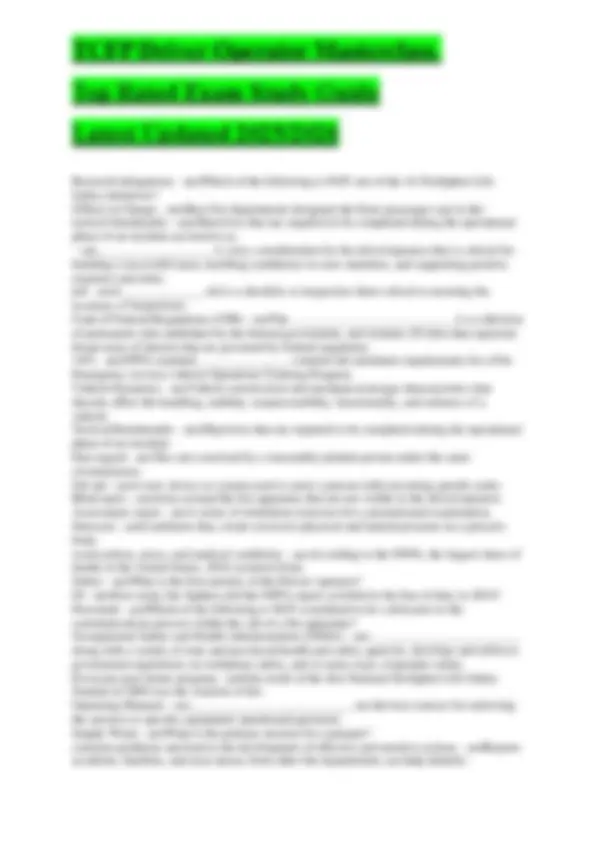
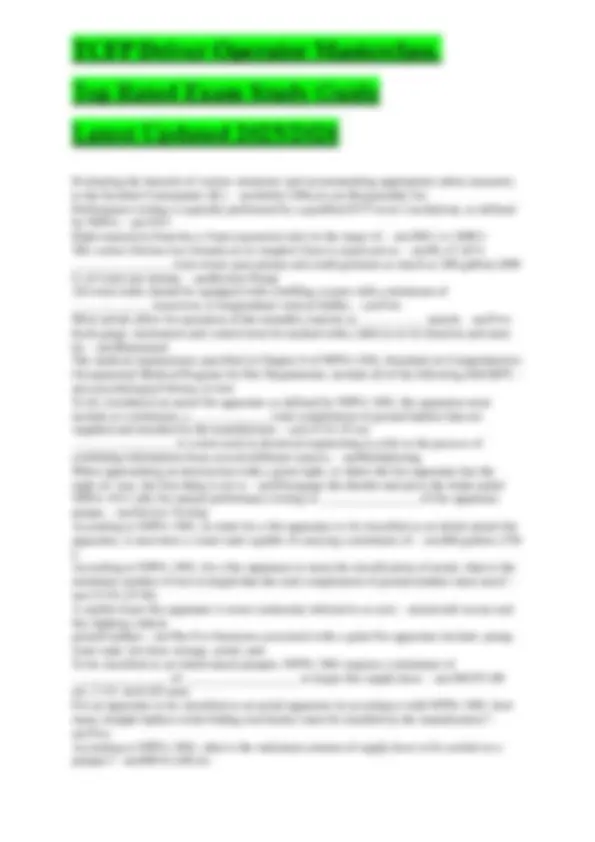
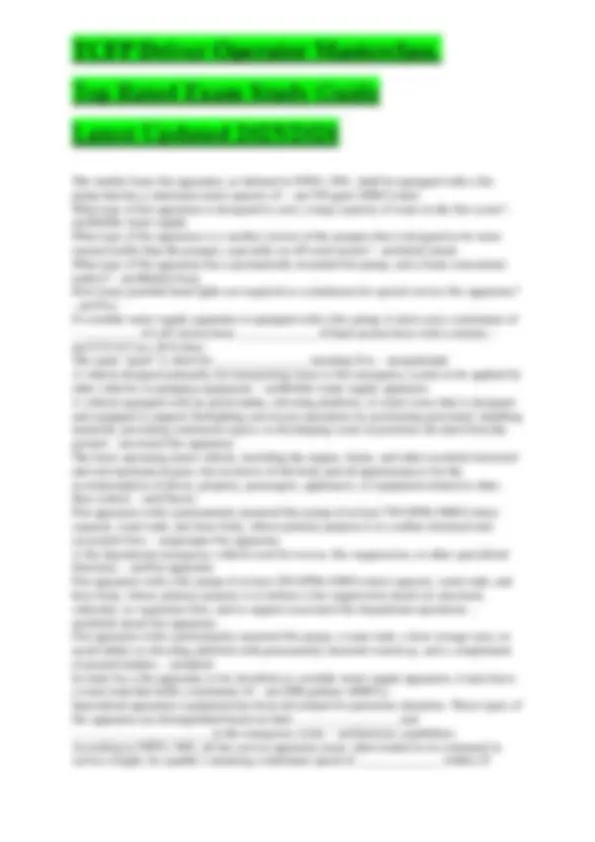
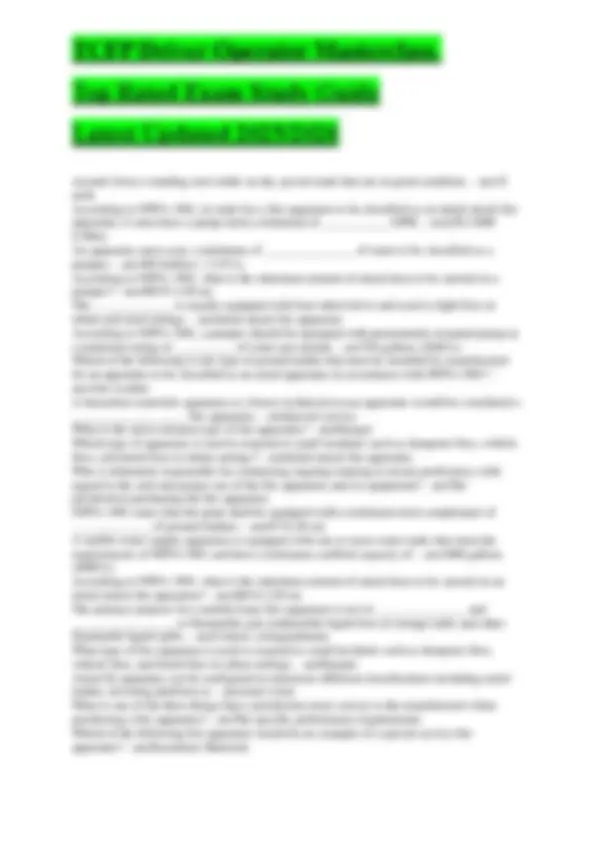
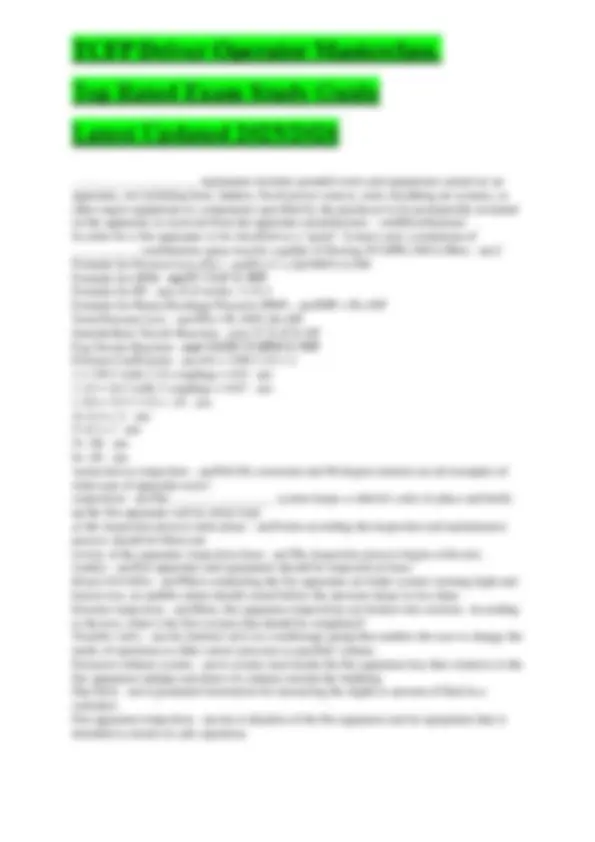
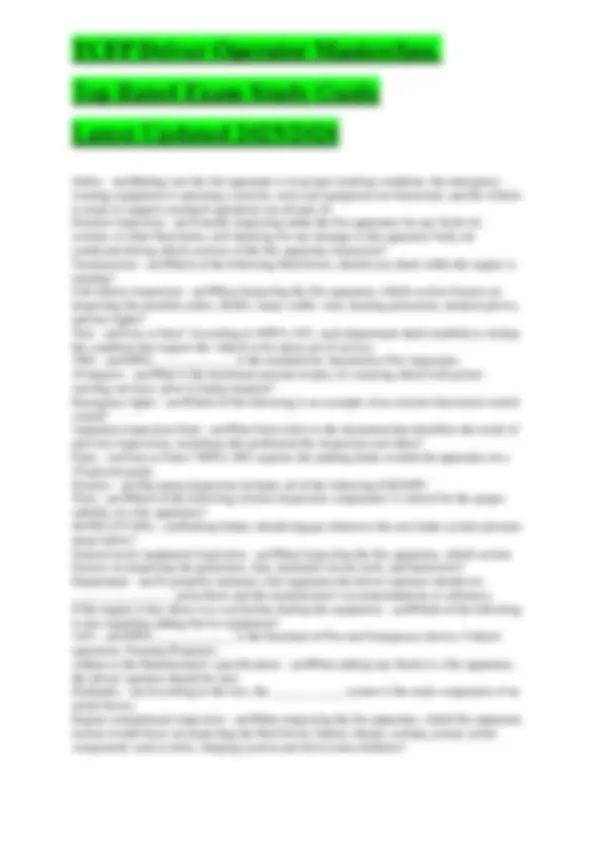
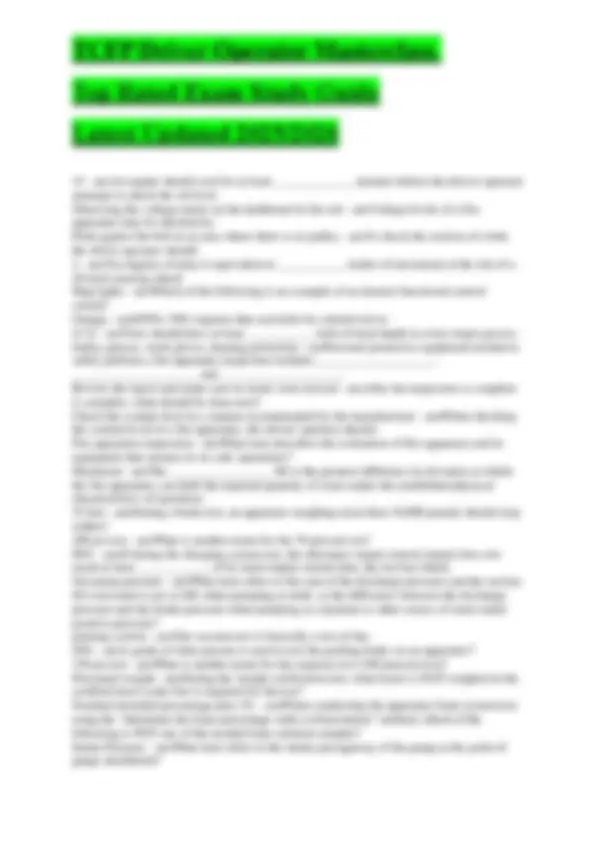
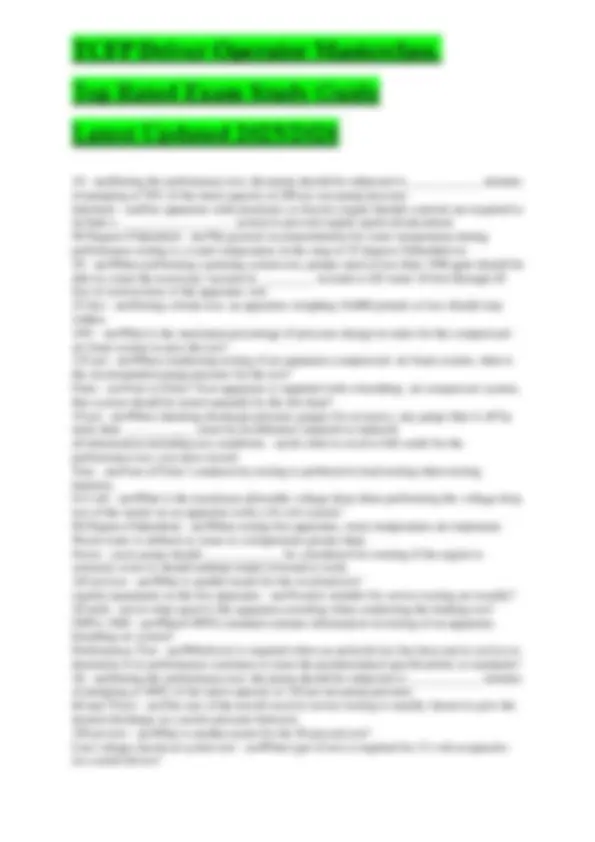
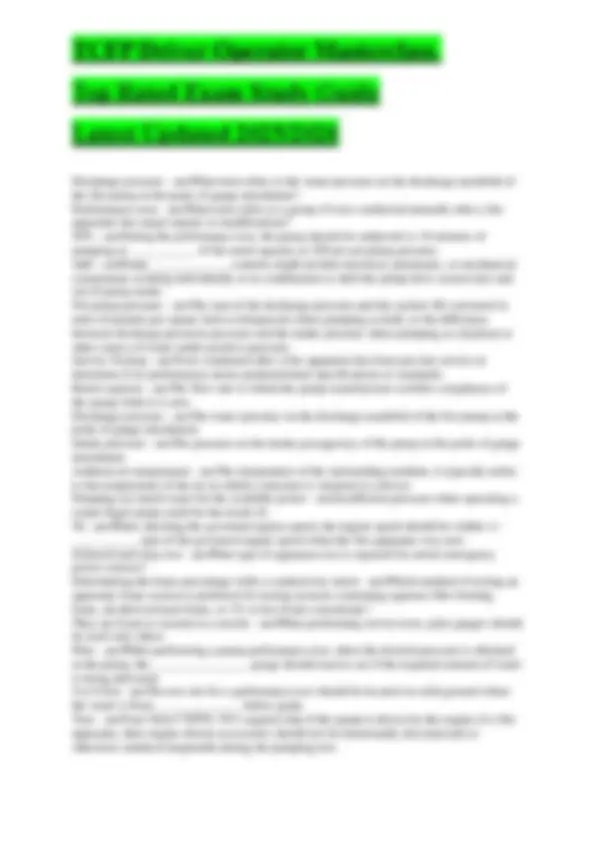
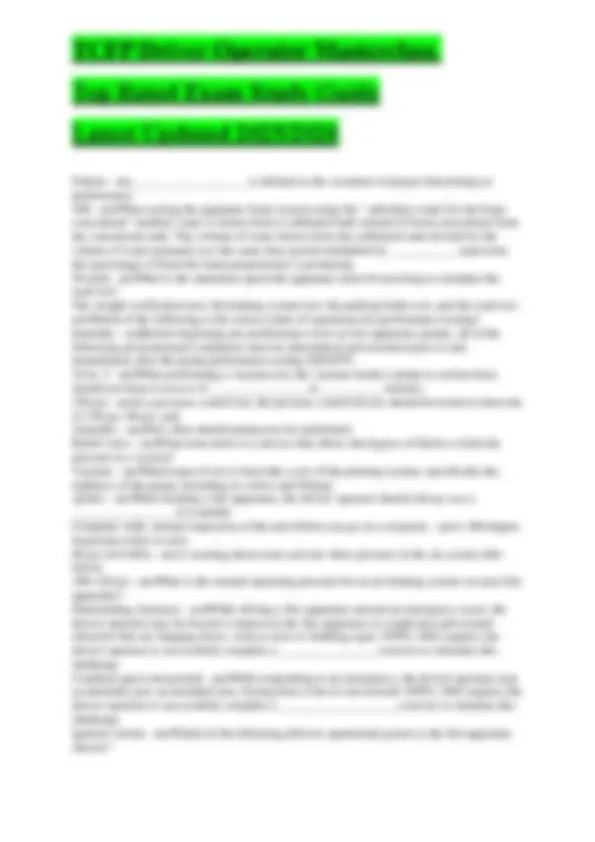
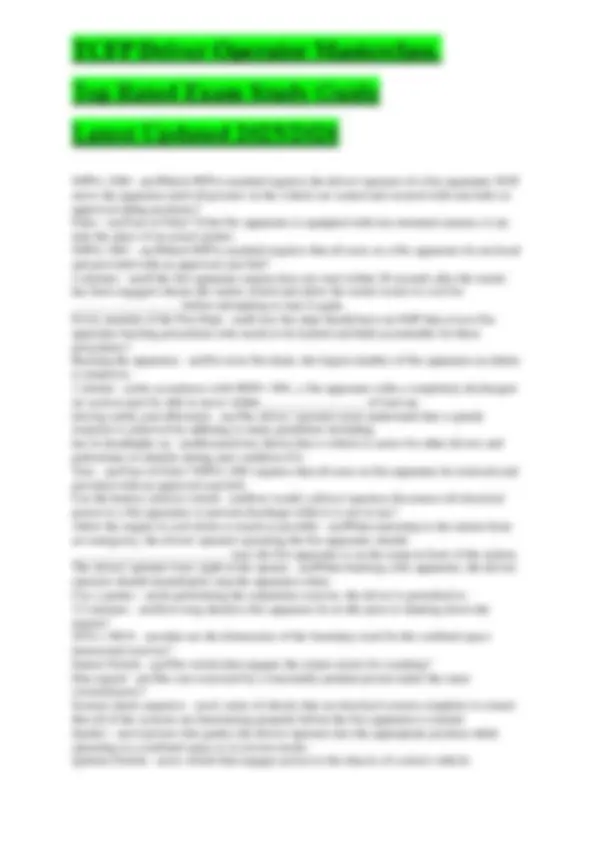
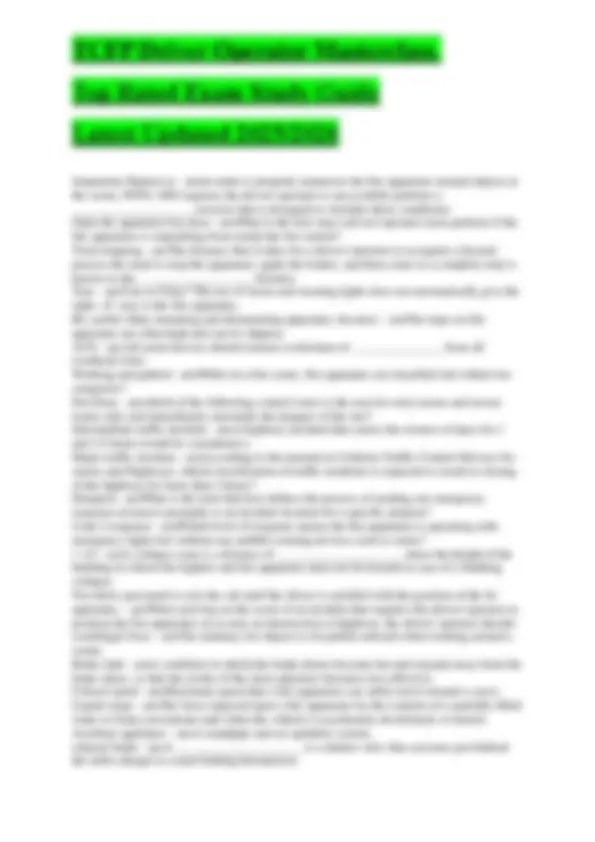
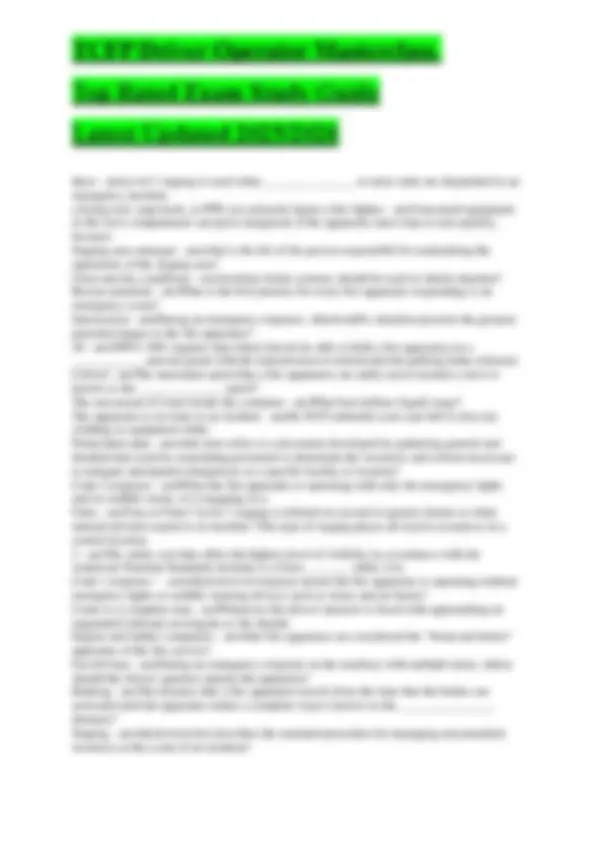
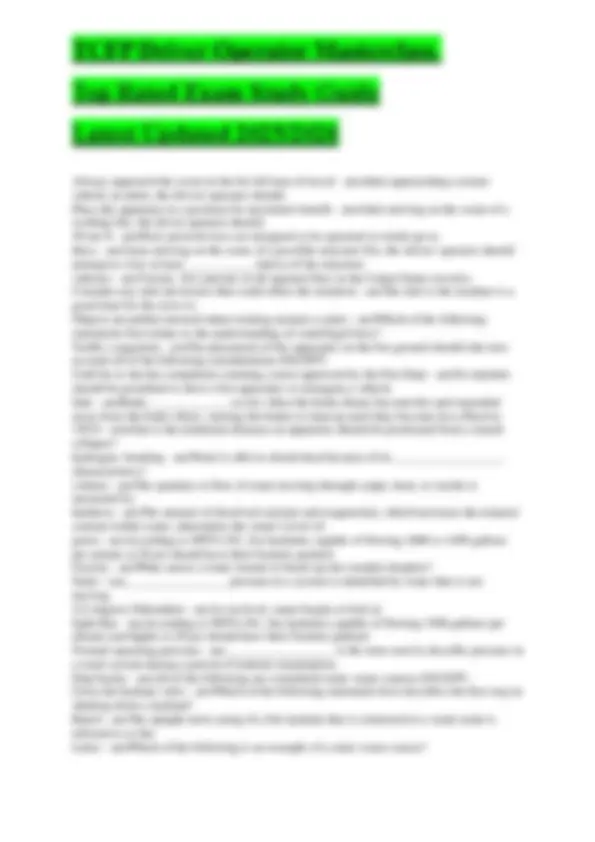
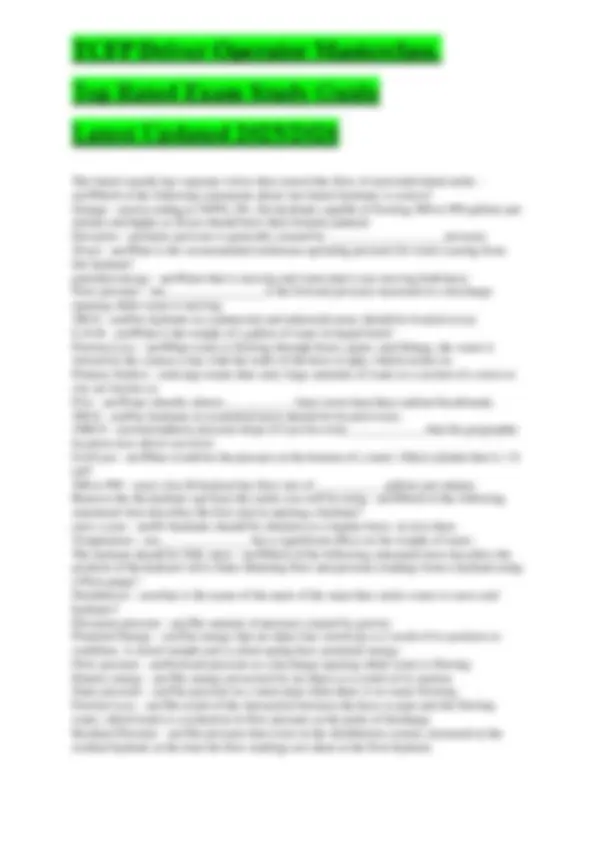
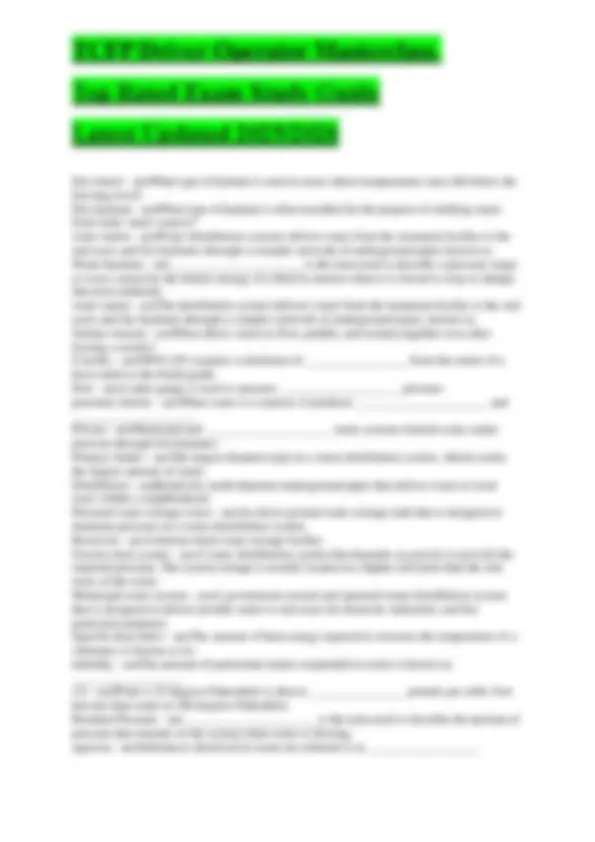
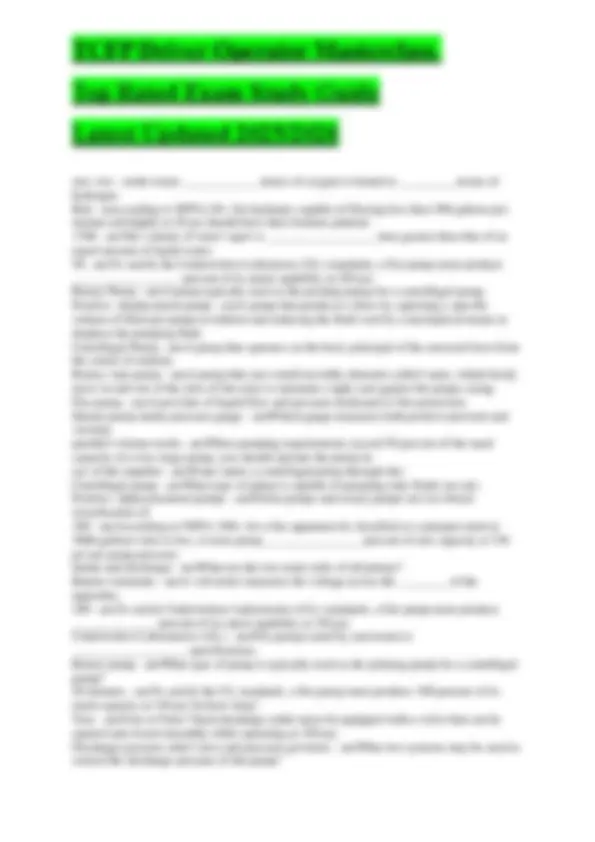
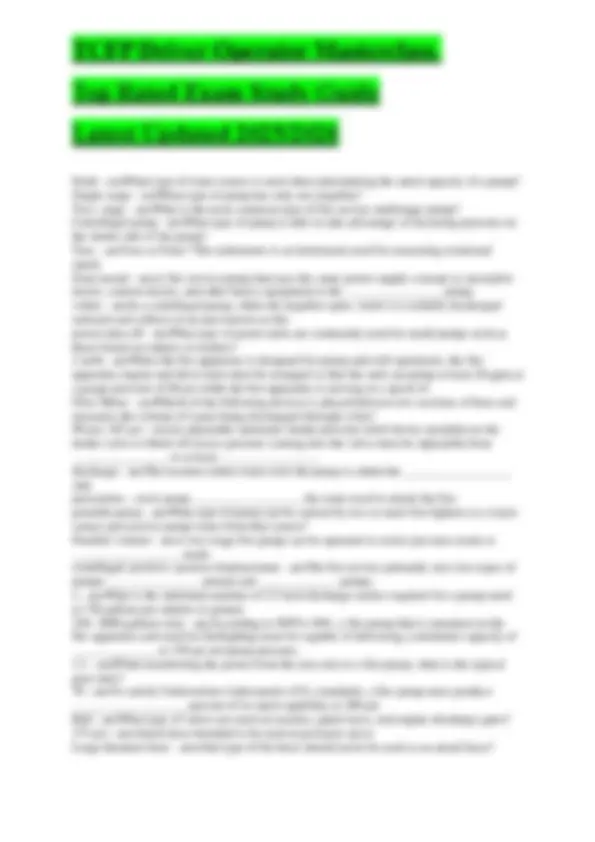
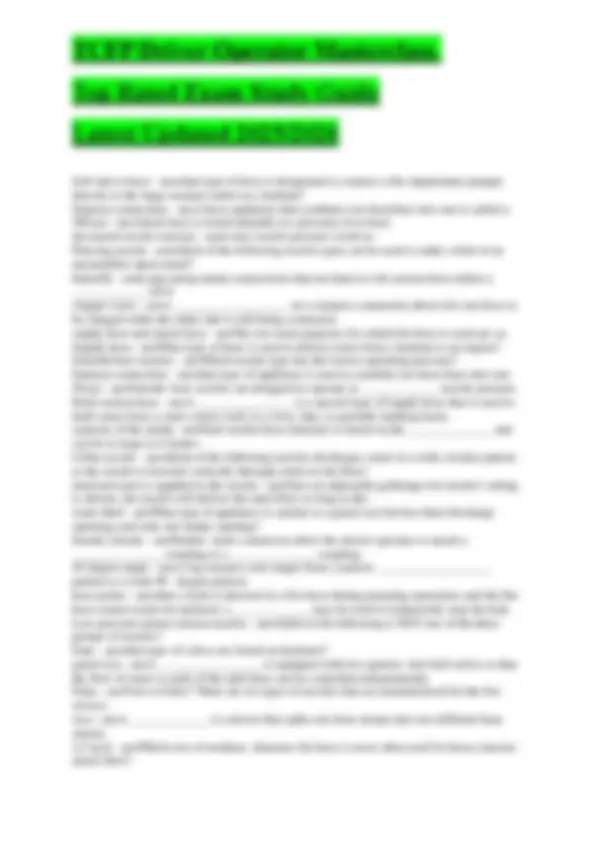
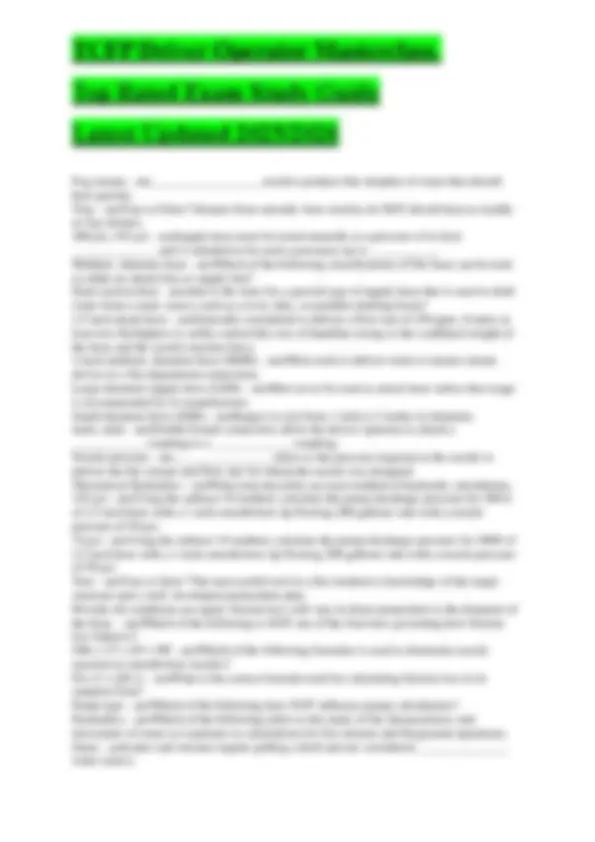
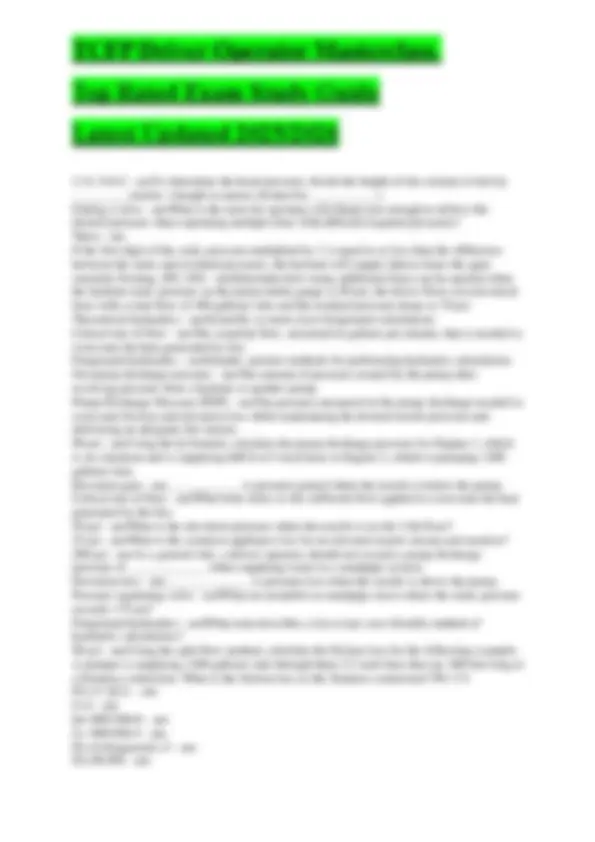
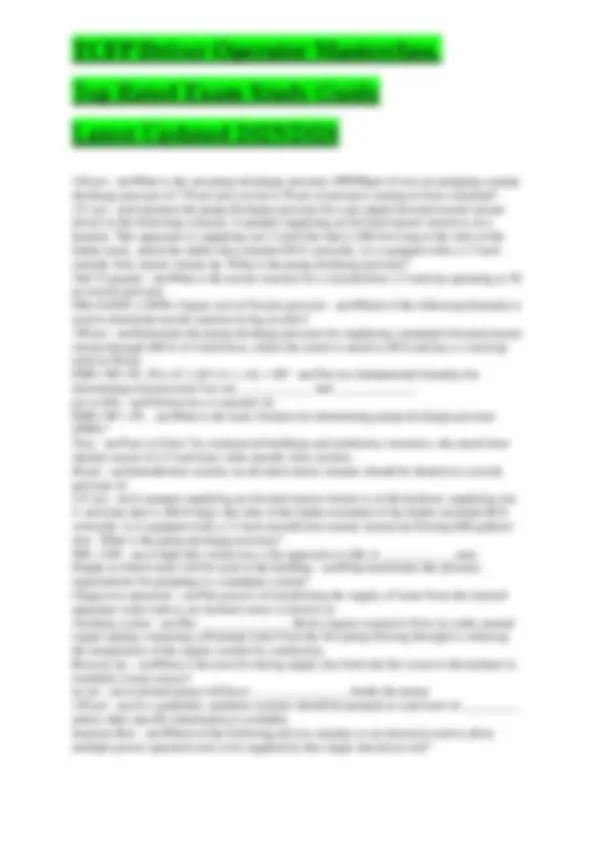
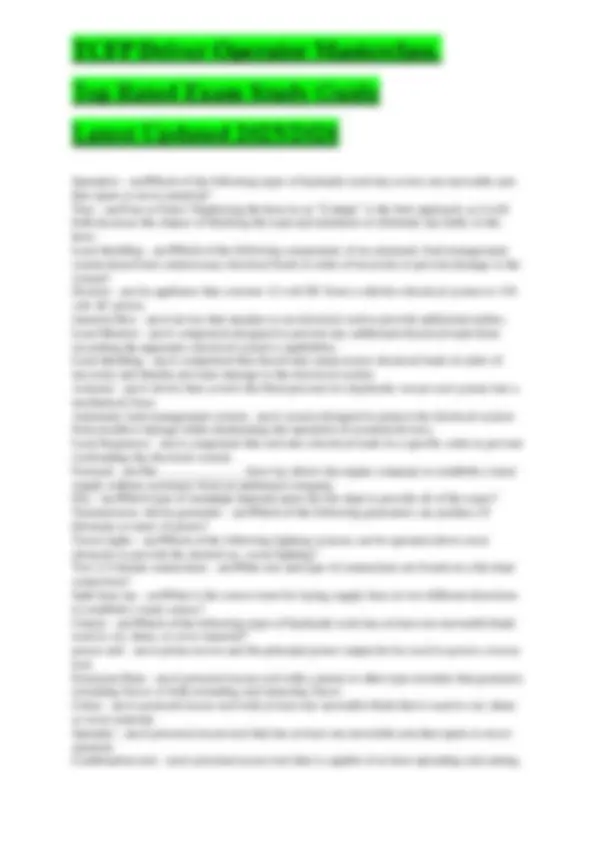
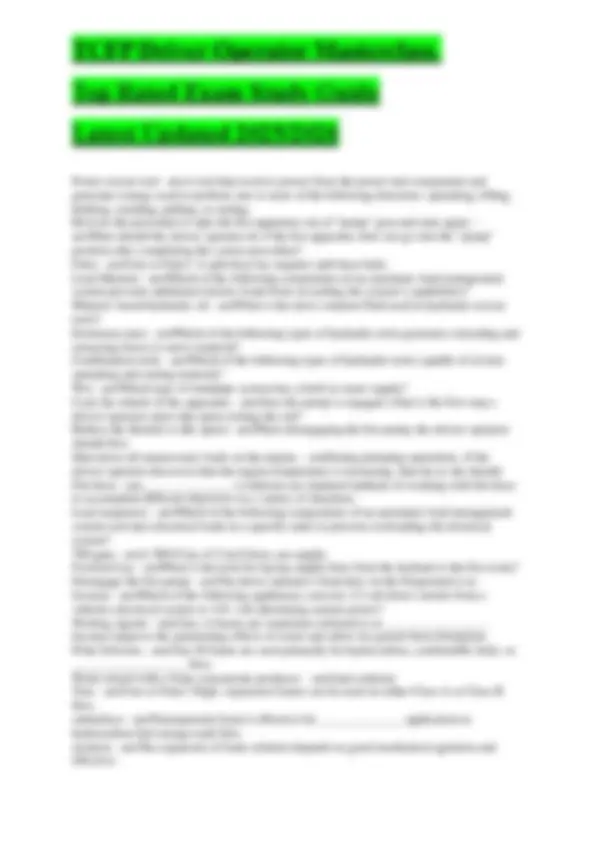
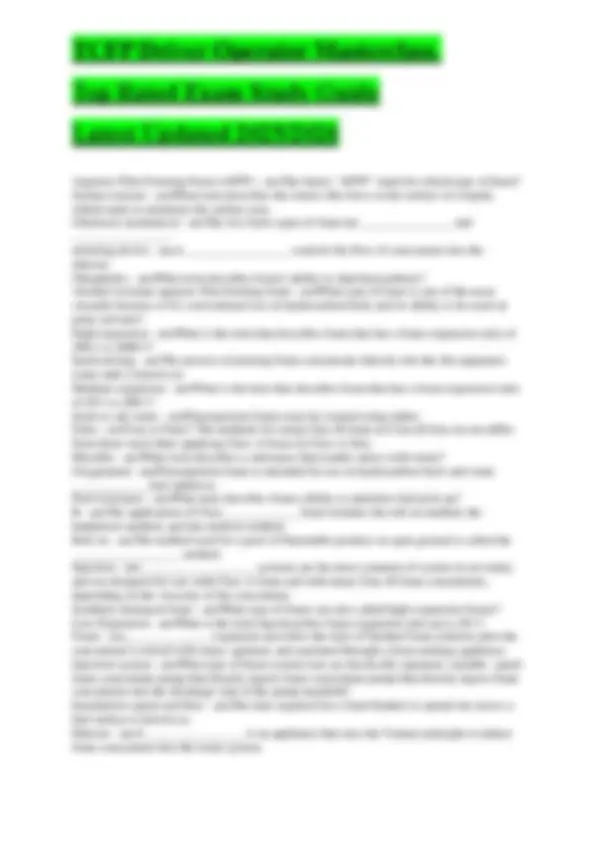
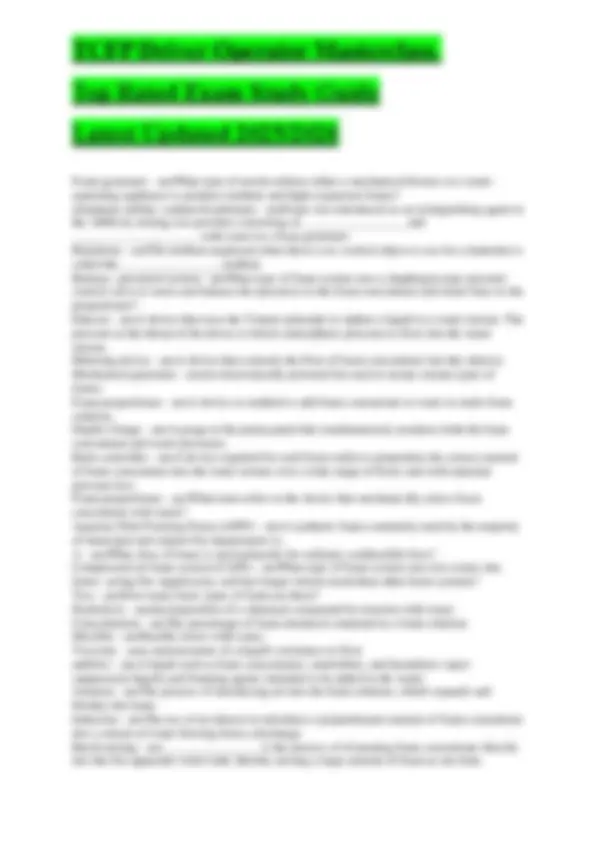
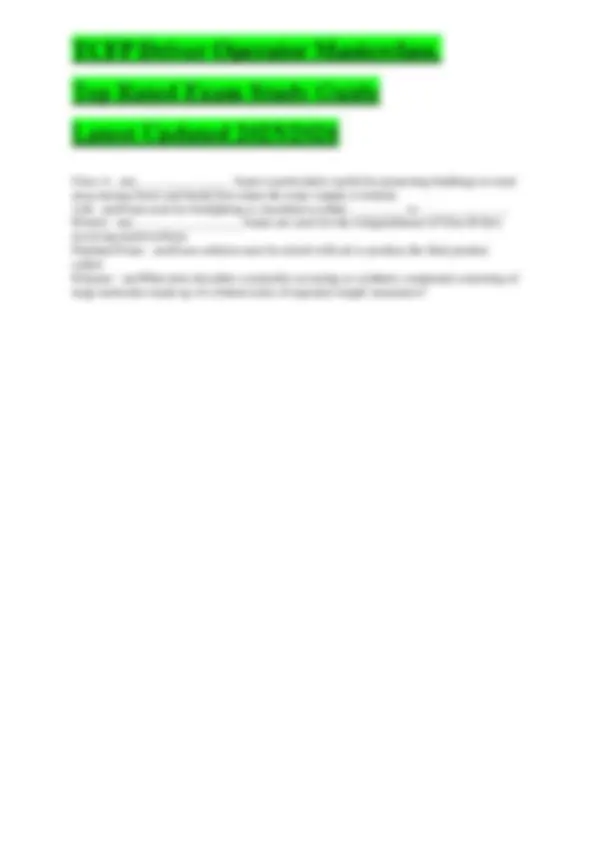


Study with the several resources on Docsity

Earn points by helping other students or get them with a premium plan


Prepare for your exams
Study with the several resources on Docsity

Earn points to download
Earn points by helping other students or get them with a premium plan
Community
Ask the community for help and clear up your study doubts
Discover the best universities in your country according to Docsity users
Free resources
Download our free guides on studying techniques, anxiety management strategies, and thesis advice from Docsity tutors
This study guide provides a collection of multiple-choice questions and answers related to the tcfp driver operator masterclass. It covers topics such as atmospheric pressure, vacuum measurement, fire pump operations, drafting operations, and water supply systems. The guide is designed to help students prepare for exams and gain a deeper understanding of the concepts covered in the masterclass.
Typology: Exams
1 / 55

This page cannot be seen from the preview
Don't miss anything!
















































Page: 328
Page: 336
B. fill site. C. dump site. D. water site. - ansanswer: B NFPA 1002: 10.2.3, 10.2.3(A), 10.2.3(B) Page: 347
A. no water B. no air C. reserved air D. reserved water - ansanswer: B NFPA 1002: 4.3.7, 4.3.7(A), 5.2.4(1), 5.2.4(2), 5.2.4(3), 5.2.4(4), 5.2.4(A) Page: 293
Page: 297
D. Phosphate ester - ansanswer: A NFPA 1002: 4.3.7, 4.3.7(A), 5.2.4(1), 5.2.4(2), 5.2.4(3), 5.2.4(4), 5.2.4(A) Page: 316
C. Straddling two middle lanes D. Whichever lane doesn't contain vehicles - ansanswer: A NFPA 1002: 4.3.1, 4.3.1(A), 4.3.6, 4.3.6(A) Page: 261
Page: 274
3 - Before a new apparatus is put into service, what must be completed? - ansTRAINING ON THE APPARATUS 4 - Approximately what percentage of the earth's surface is covered by water? - ans70-75% 4 - The amount of heat energy required to increase the temperature of a substance is known as it specific heat index. Water's specific heat index is: - ans 4 - When water is moving, it has a combination of potential energy and ________ energy. - ansKINETIC 4 - Principle 4 of fluid pressure that states, "The pressure of a liquid in an open vessel is proportional to the _____ of the vessel. - ansDEPTH 4 - One advantage of a wet-barrel hydrant is: - ansYOU CAN ADD HOSELINES WITHOUT SHUTTING OFF THE HYDRANT 4 - A fire hydrant that has a flow of 500-999 gpm at 20 psi would be considered what class of hydrant? - ansCLASS B 4 - The first part of a hydrant inspection is to: - ansCHECK THE EXTERIOR OF THE HYDRANT FOR SIGNS OF DAMAGE 4 - Flow testing should be done: - ansAT PEAK WATER FLOW TIMES 4 - Static water supplies are most commonly used in: - ansRURAL AREAS 4 - An alternative means of obtaining water in areas that are inaccessible to fire apparatus would be: - ansA PORTABLE PUMP 5 - All fire pumps are rated from a: - ansDRAFT 5 - According to NFPA standards, at 100 psi net pump pressure, a fire pump must deliver at least: - ans3000 GPM 5 - What type of pump is typically used as the priming pump for a centrifugal pump? - ansROTARY PUMP 5 - The centrifugal pump must be primed because: - ansIT CANNOT MOVE AIR 5 - When more than 50 percent of the two-stage pump centrifugal pump's rated capacity is needed on the fireground, the pump should be operated in: - ansPARALLEL/VOLUME MODE 5 - In most pumping operations, you will supply one or two handlines with a total flow of 300 - 400 gpm of water. A 1000-gal two-stage pump can easily supply this amount while operating in: - ansSERIES/PRESSURE MODE 5 - Each intake valve that has a connection larger than 3 inches must be equipped with an: - ansAUTOMATIC INTAKE PRESSURE RELIEF DEVICE 5 - One instrument NOT installed on the pump operator's panel is the: - ansFLOW METER 5 - Engines operate at different oil pressures, so the operator must be familiar with the normal _____ range for the oil pressure in each apparatus they operate. - ansOPERATING 5 - A front mount pump would most likely be getting is power from the: - ansCRANKSHAFT 6 - Medium-diameter hose has a diameter of __________, and is used as either supply line or attach line. - ans2-1/2" or 3 INCHES 6 - A single 5-inch supply line can deliver flows exceeding: - ans1500 GPM 6 - Which of the following would NOT be considered a fire hose appliance? - ansSMOOTH- BORE NOZZLE 6 - Closing a valve too quickly will cause: - ansWATER HAMMER
6 - Most smooth-bore nozzles are designed to operate at: - ans50 PSI 6 - Which nozzle would operate with less air movement and thus less disturbance of the thermal layering? - ansSOLID-STREAM 6 - One benefit of using lower nozzle pressure is: - ansTHE NOZZLE IS EASIER TO CONTROL 6 - A hose jacket can be used to: - ansTEMPORARILY STOP A LEAKING HOSE 6 - If a soft sleeve hose uses Storz connections, before charging the line you should always make sure: - ansTHE COUPLING IS LOCKED 6 - Why are hose clamps often applied to supply lines before they are charged? - ansDOING SO ALLOWS THE LINE TO BE CHARGED BEFORE IT IS CONNECTED TO THE ATTACK PUMPER 7 - Smooth-bore nozzles on prepiped elevated master streams are commonly rated at a nozzle pressure of: - ans80 psi 7 - The formula NR=1.57 x d2 x np is used to calculate the nozzle reaction for which kind of nozzle? - ansSMOOTH-BORE NOZZLES 7 - Calculate the flow rate for a 1-1/4" tip used on a 2-1/2"handline (the constant is 29.7 and the nozzle pressure is 50) - ans328 gpm 7 - In the formula to calculate friction loss, the L is: - ansTHE LENGTH OF THE HOSELINE DIVIDED BY 100 7 - For all master stream appliances, you can estimate that the friction loss will be: - ans25 psi 7 - Calculate the elevation pressure change if you're supplying water to a high-rise building (with 10 ft ceilings) with a fire on the fifth floor. - ans20 psi 7 - In the percentage method, you calculate the total flow through one line. The FL in two hoselines will be ___ percent of the total flow through one hoseline, and the FL in three hoselines will be approximately ____ percent of the total flow through one hoseline. - ans25: 7 - Since you can generate just one pressure into a standpipe, what would you send if you used two attack lines, one that needed 165 psi and one that needed 135 psi? - ans165 psi 7 - Net pump discharge pressure from a static source is referred to as: - ansNPDP draft 7 - The subtract 10 method can be used to determine friction loss in what size hose only? - ans2-1/2 inches 8 - The first priority when performing an inspection is: - ansPersonal safety 8 - The inspection should be performed: - ansExactly the same way every time 8 - What piece of US currency can be an effective tool when inspecting an apparatus? - ansQuarter 8 - When checking oil levels, how long should you wait after shutting off the engine, before doing a dip stick test? - ans15 minutes 8 - New apparatus manufactured after 2010 may have an additional tank of diesel exhaust fluid used to: - ansMeet the new emission requirements 8 - Exterior functional control switches are located: - ansInside the cab 8 - Even if the water tank has a level gauge, a visual inspection of the water supply tank should be conducted, because: - ansYou can verify the accuracy of the gauge 8 - When inspecting the pump: - ansyou inspect against the flow, discharge to intake